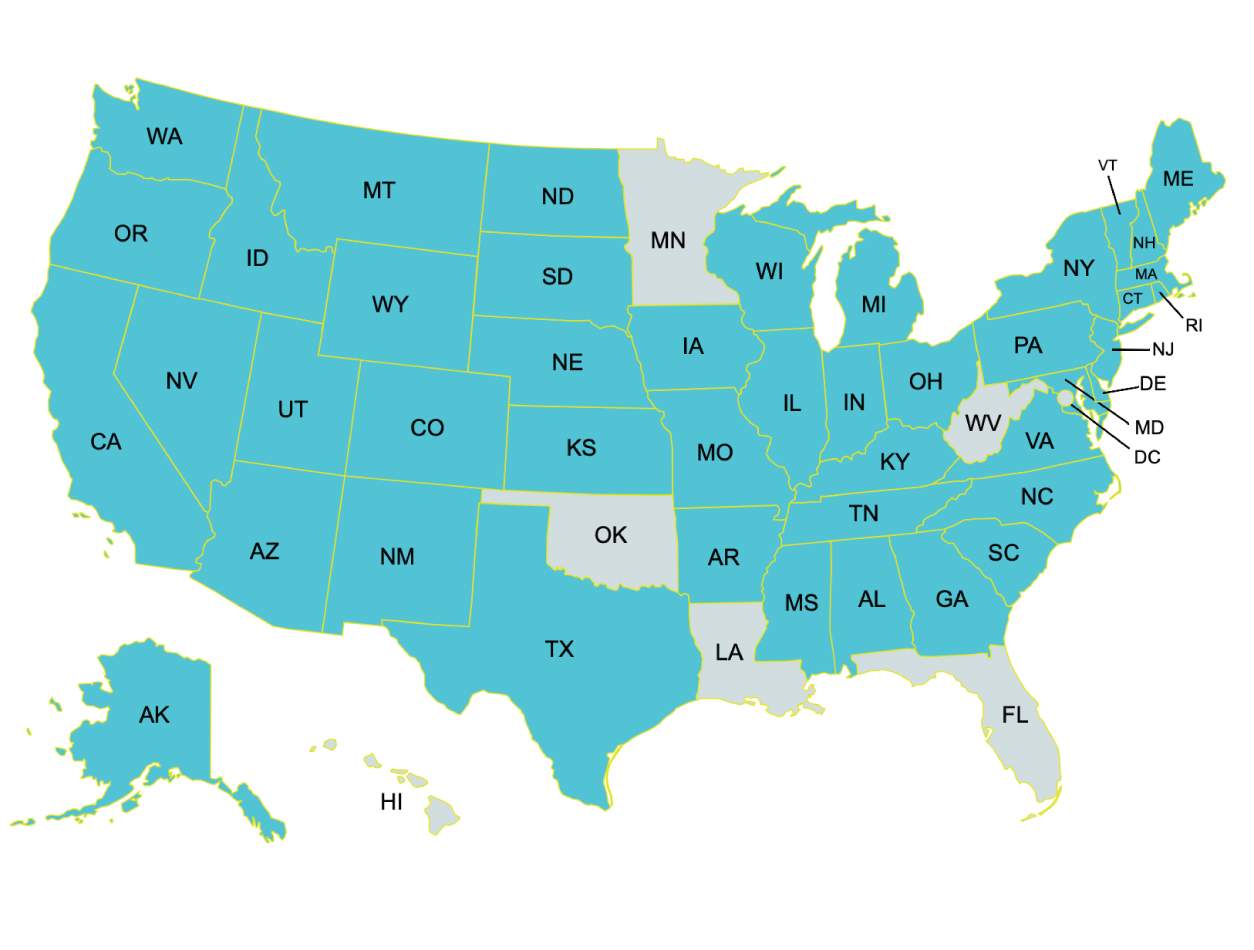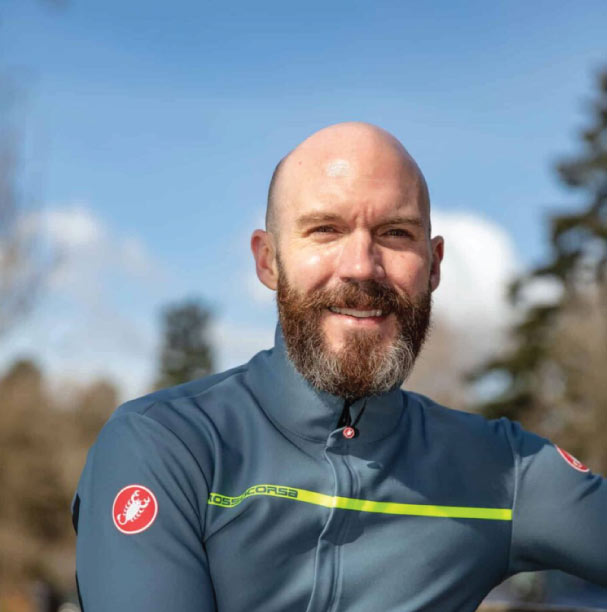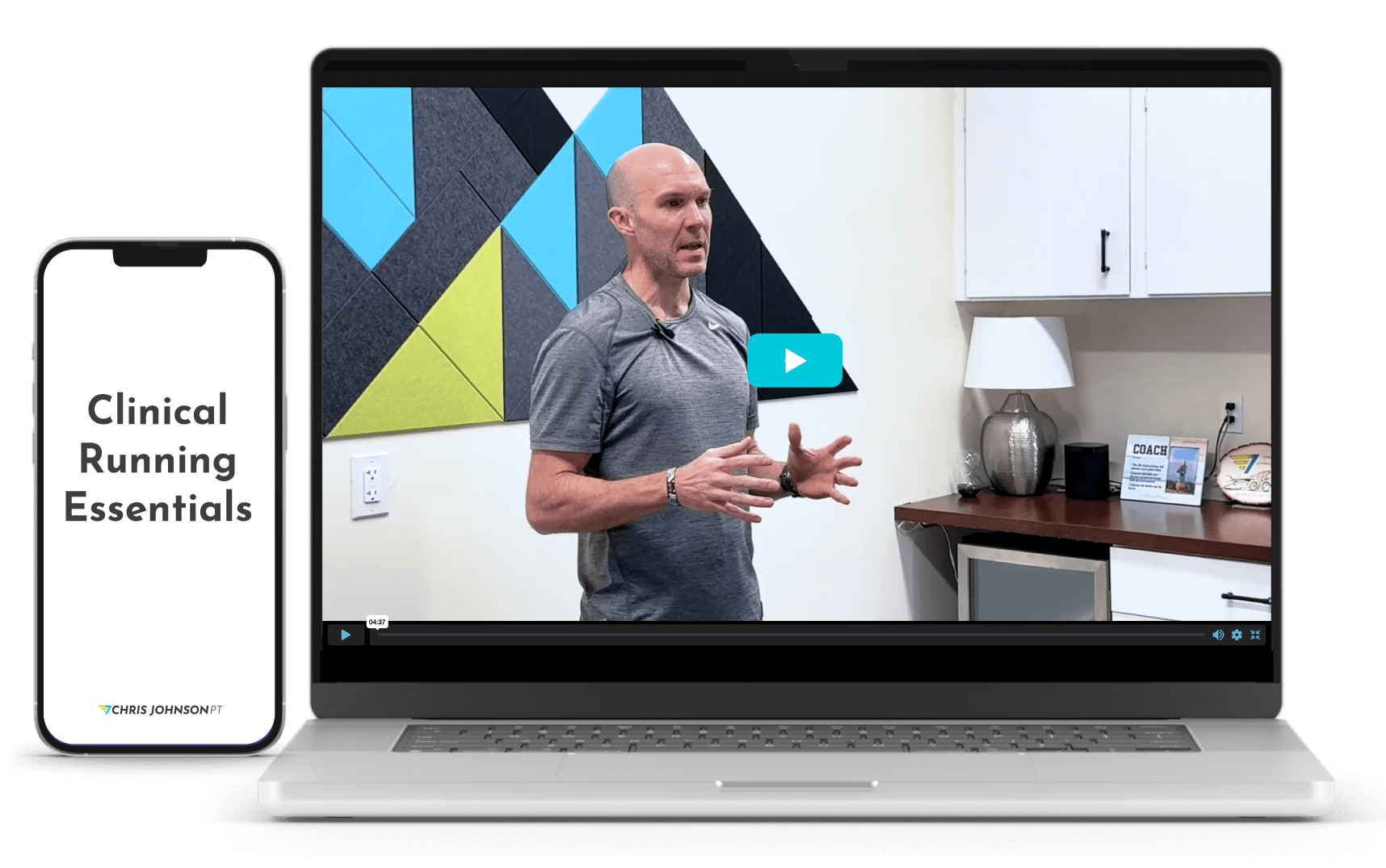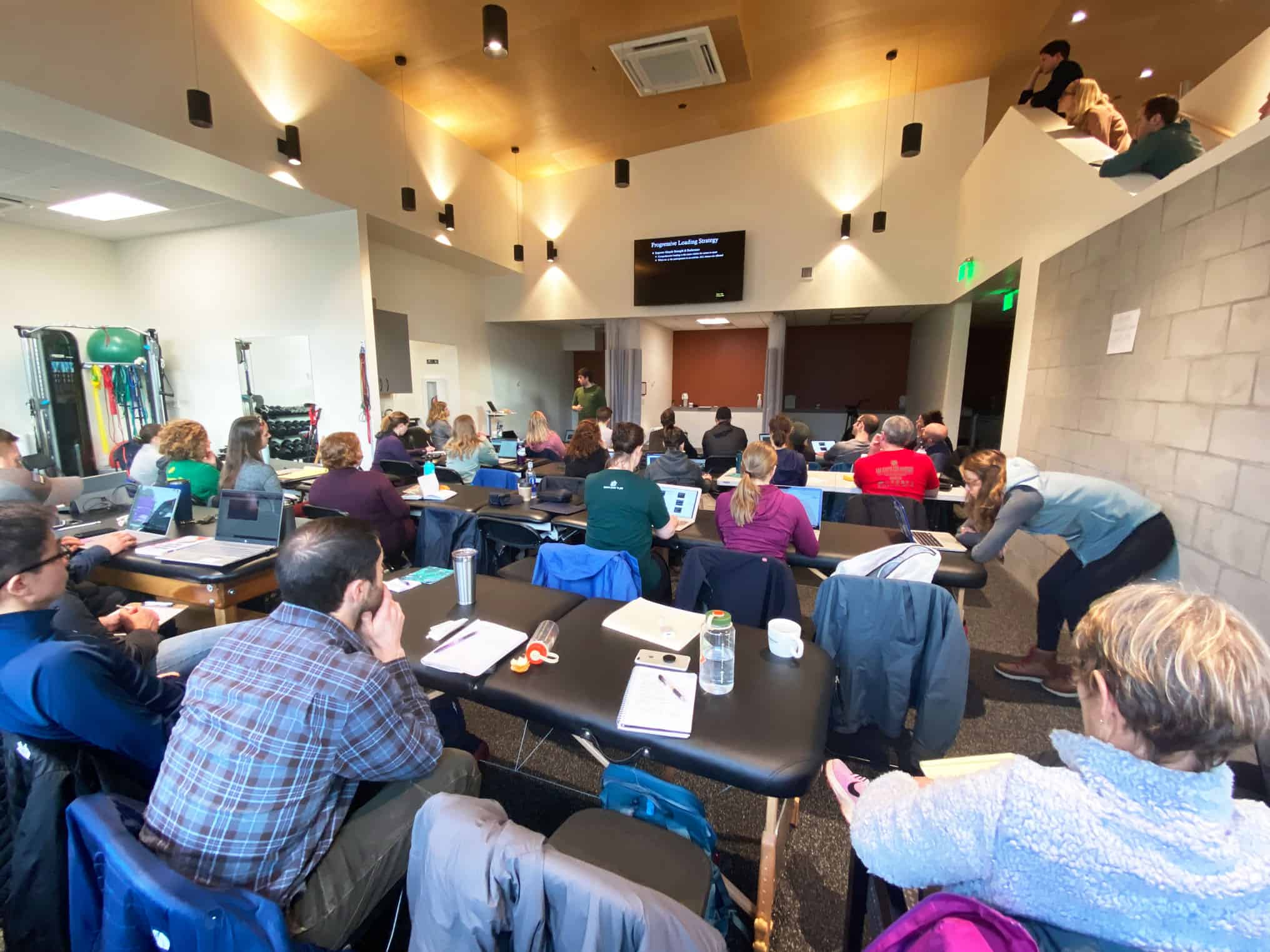New! Online Course
Clinical Running Essentials

Taught by Chris Johnson, PT
📖 100% Online, Self-Paced Course
🏅 Approved for 20 CEUs for PTs (details below)
🔄 Lifetime Access
Confidently treat runners with bone stress injuries, lower limb tendinopathy, and movement dysfunction using proven strategies for assessment, rehab, and performance.
Designed for clinicians working with runners or eager to expand into running-related care, this course distills 20+ years of clinical expertise into a clear, evidence-based approach, eliminating guesswork and improving clinical decision-making.
A note from Chris:
Early in my career, I assumed my clinical education had fully prepared me to treat runners.
After all, I understood biomechanics, tissue loading, and rehabilitation principles. But once I started working with runners in practice, I quickly realized something was missing.
Runners weren’t responding the way I expected. Some injuries kept coming back. Others worsened despite following “best practices.”
I saw bone stress injuries that were initially (dis)missed, tendinopathies that didn’t improve, and runners eager to return to training before they had fully restored tissue capacity.
I started asking myself: What am I missing?
That question led me down a path of deeper study, hands-on experience, and learning from some of the best in sports medicine.
Over the past 20 years, I’ve worked as a clinical research assistant at NISMAT, collaborated with top surgeons, coached endurance athletes, and competed in marathons and Ironmans.
Through all of it, I developed a clearer, more structured approach to running injuries—one that bridges the gaps I didn’t even know existed when I started.
I refined an approach that integrates:
✔ Identifying injury patterns unique to runners before they become chronic
✔ Using objective performance tests to ensure actual return-to-run readiness
✔ Applying progressive loading principles that work in practice
✔ Communicating effectively with runners to improve adherence and long-term outcomes
That’s why I created Clinical Running Essentials.
This course isn’t about learning protocols or a specific system—it’s about ensuring that clinicians treating runners have a strong foundation in the essentials.
It’s the knowledge I wish I had earlier in my career, structured in a way that makes it easy to absorb and apply.
By completing this course, you’ll cover all critical areas of running injury management, refine your clinical reasoning, and provide better care for runners—so they can return to the sport they love with confidence.
Earn CEUs by taking Clinical Running Essentials online
Clinical Running Essentials is approved for CEUs for Physical Therapists in CA, NY, and TX and recognized by most other state PT boards.
States in blue on the map are approved, and you can find written details in the table below.
- FL, HI, LA, MN, OK, and WV, which require separate approval.
- Washington, DC typically accepts these approvals but may have additional requirements.

Who this course was designed for:
Clinical Running Essentials is designed for clinicians who work with runners or wish to expand their expertise in treating running-related injuries.
It provides a structured, research-supported approach to managing the most critical conditions encountered in endurance athletes.
This course is most relevant for:
-
- Physical Therapists
- Chiropractors
- Athletic Trainers
- Medical Doctors & Orthopedists
- Coaches & Strength Professionals
If you work with runners recovering from injury, experiencing persistent pain, or optimizing performance, this course ensures you are thoroughly equipped to address their needs.
What You’ll Gain from taking Clinical Running Essentials
This course gives you the exact knowledge, skills, and tools to confidently assess and manage runners at every stage—from injury to peak performance.
Topics include:
🦴 Bone Stress Injuries – Detect early signs, understand imaging, and apply risk models to prevent mismanagement and ensure safe recovery.
🔹 Lower Limb Tendinopathies – Assess and treat Achilles, patellar, glute med, and proximal hamstring tendinopathies with progressive loading and return-to-run protocols in the context of the bio-psycho-social model.
📊 Physical Performance Testing – Use structured assessments to test tissue capacity specific to the performance demands of running while ensuring full readiness for return to sport.
🧠 Communication & Behavior Change – Use motivational interviewing and educational strategies to improve alliance, foster autonomy, and enhance rehab engagement.
🏋️♂️ Strength & Control Drills – Restore capacity through a combination of progressive loading as well as power and plyometric drills while implementing motor control strategies to enhance running economy, reduce injury risk, and improve movement efficiency.
📈 Return-to-Run Programming – Use criteria-based progressions to guide runners back to training with objective checkpoints and benchmarks to prevent re-injury.
📏 Orthopedic & Clinical Examination – Apply evidence-based assessments to evaluate runners’ joint integrity, soft tissue health, and functional movement.
👟 Running Biomechanics – Develop a structured approach to gait analysis, load management, and movement optimization.
💡 Case Studies & Clinical Applications – Refine diagnostic and treatment skills with real-world runner case studies for seamless clinical application.
This course eliminates the uncertainty of working with runners, giving you the structured, proven tools to help your patients recover, stay injury-free, and perform at their highest level.
Course Overview
Description
Running is one of the most accessible and beneficial forms of exercise, yet it has a high risk and incidence of lower extremity injuries. Research shows that nearly 80% of runners sustain an injury each year, often due to overuse-related conditions, frequently resulting in bone stress injuries, tendinopathies, and fasciopathies.
When not correctly identified and managed, these injuries can become chronic, delaying return to sport for weeks, months, or even years. In severe cases, mismanagement can lead to long-term impairments that impact athletic longevity and overall health.
Clinicians treating runners must understand the sport’s unique biomechanical and performance demands, the pathophysiology of common injuries, and evidence-based rehabilitation strategies.
This course provides a structured, research-driven approach to help clinicians accurately assess, manage, and guide runners out of the medical system and back to pain-free, sustainable training.
Technical Details
Format: 100% Online, self-paced course
Length: ~20 hours
Content types:
- Video lectures
- Video tutorials
- Video demos
- PDF downloads where applicable
Curriculum
How to Get the Most Out of This Experience
Motivational Interviewing, Alliance Building, and Inductive Foraging
In this module, you'll:
- Leverage presence, language, and curiosity to help runners take ownership of their rehab journey
- Understand athlete archetypes (Apollonian, Dionysian, Odyssean) to better connect and communicate
- Apply the 5 principles of Motivational Interviewing to foster change without resistance
- Build Level 2 relationships rooted in trust, openness, and shared understanding
- Use Self-Determination Theory to support autonomy, competence, and relatedness in care
- Shift from checklist history-taking to narrative listening that uncovers what truly matters
What Clinicians Need to Know
In this module, you'll:
- Break gait into absorption, propulsion, and swing—and identify where inefficiencies tend to show up
- Understand running form as a dynamic signature shaped by injury, context, and aging
- Know which mobility and ROM thresholds matter most for walking, running, and sprinting
- Decode key tempospatial metrics—cadence, contact time, stride length—and their impact on performance
- Grasp the force demands on high-impact players like the soleus, quads, and lateral glutes
- Learn how speed influences mechanical strategy—and how that impacts injury risk in distance runners vs. sprinters
Staging and Typing Running-Related Pain and Injury
In this module, you'll:
- Learn a simple 5-stage model to classify RRIs based on severity, functional impact, and red flag indicators
- Differentiate between tendon and bone stress presentations using pain timing and response to loading
- Use staging to guide running clearance, loading decisions, and communication with athletes and physicians
- Identify critical red flags (e.g. altered mechanics, ADL avoidance, pain at rest) that demand a shift in care approach
- Apply this model in real-world scenarios to simplify clinical reasoning and improve outcomes across injury types
Strategies for Direct Access Providers
Revealing an Overlooked Clinical Pattern in Runners
In this module, you'll:
- A novel, supine-based test designed to assess dynamic foot control, torsional mobility, and hip-ankle interaction
- Detects key clinical patterns often missed, like asymmetric toe-out, limited ankle DF, terminal knee extension deficits, and subtle rotational asymmetries
- It seamlessly integrates with gait analysis, squat assessments, and closed kinetic chain tasks to refine clinical decision-making and exercise prescription
- Provides actionable insight for both manual therapy and exercise prescription—bridging assessment and intervention with precision
Establishing Baselines, Benchmarks, and Clearance Criteria for Safe Return to Running
In this module, you'll:
- Learn a structured, scalable battery of functional tests to establish a baseline and determine readiness for run progression
- Includes low-cost, time-efficient assessments that evaluate mobility, strength, neuromotor control, and reactive capacity
- Walk through each test: toe dexterity, single-leg stance, air squat, lateral step-down, calf raise, side planks, long-lever bridge, pogos, and single-leg hopping
- Understand the rationale for each test based on load demands during running (e.g., soleus forces greater than 6.5x BW) and where deficits typically show up
- Equip yourself with a system that balances simplicity and scientific rigor—designed to improve decision-making and patient confidence
- Use this battery to create a legally sound, performance-ready bridge from rehab to running
Tendon-Specific, Individualized Care for Runners
In this module, you'll:
- Revisit tendon anatomy, structure, and the limits of our current understanding—especially in the context of pathology
- Clarify key terms (tendinopathy, tendinitis, paratendonitis) and understand how tendon pain can exist without visible structural damage
- Learn how to apply the continuum model of tendinopathy to guide clinical decision-making and loading progressions
- Explore the role of compression, intratendinous pressure, and neovascularization in pain and healing
- Dive into sex differences, central sensitization, imaging limitations, and other often-missed variables in persistent tendon cases
- Compare loading strategies (eccentrics, HSR, isometrics, plyometrics) and understand the importance of strain magnitude and duration
- Discover how tendon stiffness, strain thresholds, and muscle-tendon mismatch influence injury, adaptation, and performance
- Leave with a practical toolkit to assess, dose, progress, and educate patients using individualized rehab pathways—not cookie-cutter protocols
Step by Step, Bone by Bone – What you need to know
In this module, you'll:
- Learn the structural, hormonal, and loading-based underpinnings of bone adaptation—and how strain imbalances lead to injury
- Understand the full BSI pathology continuum, from asymptomatic remodeling to stress reaction and fracture
- Master the difference between cortical vs. trabecular bone, high- vs. low-risk sites, and how to clinically differentiate BSIs from tendinopathy
- Get clear on risk factors, including RED-S, energy availability, and sex-specific vulnerabilities—plus how to screen for them in real time
- Build confidence managing direct access care, including when to offload, when to refer, and how to advocate for imaging
- Learn a complete, phased rehab strategy with objective return-to-run criteria, step count progressions, and loading strategies that respect tissue timelines
- Explore the long game: how to promote bone health across the lifespan, select footwear wisely, and understand the adaptive interplay between bone, tendon, and muscle
- Go region-by-region to examine clinical patterns, assessment nuance, and decision-making strategies for each relevant site of injury
With Special Consideration for Bone and Tendon Health
Qualitative & Quantitative Gait Analysis and Retraining for Clinicians
In this module, you'll:
- Master the "S’s of Treadmill Analysis" (Strike, Step Rate, Sound, Symmetry, Shank, etc.) to simplify observation and clinical decision-making
- Combine qualitative analysis with Runeasi metrics to enhance assessment and clearly communicate findings to clients
- Know how treadmill and overground running differ—and why it matters for rehab and retraining
- Clarify the truth about foot strike patterns and why heel striking isn’t the villain it’s made out to be
- Use cadence manipulation to reduce joint loading and shift muscular demand in common running injuries
- Deliver clear, actionable feedback through simple external cues that drive motor learning
- Follow best practices for camera setup, runner familiarization, and session protocols to improve reliability
Programming, Progression, and Autoregulation Basics
In this module, you'll:
- Understand the physiological and performance benefits of strength training—even for high-level runners with zero lifting background
- Explore the "interference effect," concurrent training, and why resistance work won’t sabotage VO₂ max or endurance
- Learn the what, when, and how of resistance training: exercise selection, loading zones, frequency, timing, and periodization
- Master autoregulatory principles to align rehab and performance with how an athlete actually feels, not just what the plan says
- Apply tools like RPE scales, HR monitoring, and readiness cues to adjust effort in real time
- Walk through real-world progressions using Dan John’s movement fundamentals (push, pull, hinge, squat, carry, locomote)
- Access practical drill libraries (e.g. flow rope, step-ups, calf raises, bridges, and energy storage drills) you can program immediately
- Gain strength benchmarks for runners that go beyond aesthetics or reps—focused on performance, durability, and GPP
What you need to know as a clinician
In this module, you'll:
- Break down the physiology behind endurance—understand aerobic capacity, lactate thresholds, VO₂ max, and the Fick equation without getting lost in jargon
- Learn to apply RPE and heart rate zones in real-world training plans using both 3-zone and 5-zone models (polarized, pyramidal, threshold)
- Master quick, field-based testing protocols (5-min VO₂ max, 30-min LT test, cardiac drift) that guide smarter run programming
- Understand how external (pace, load), internal (HR, lactate), and perceived (RPE) measures interact—and how to coach around them
- Translate performance metrics into tailored programming for untrained, returning, or advanced runners based on intensity, frequency, and recovery demands
- Get clarity on lactate testing (practical vs. lab-based) and when it’s worth doing—or skipping
- Learn to identify fatigue, inefficiency, and overtraining patterns through real-time data interpretation
- Walk away with a system to evaluate, program, and progress endurance athletes that aligns with both clinical rehab and elite coaching principles
Selection, Screening, and Clinical Considerations
Coming soon (Femoral neck BSI, proximal hamstring tendinopathy, tibial BSI, sacral BSI, achilles tendinopathy)
Meet Your Instructor
Chris Johnson, PT
Chris completed his undergraduate studies at the University of Delaware, earning a Bachelor of Science with distinction while conducting a senior thesis under Dr. Lynn Snyder-Mackler. He was a varsity men’s tennis team member, scholar-athlete, and team captain in 2000, receiving the Lee J. Hyncik Award for excellence.
He stayed at Delaware for a physical therapy degree, completing an orthopedic/sports fellowship under Dr. Michael J. Axe. After graduation, he worked at NISMAT at Lenox Hill Hospital in NYC for eight years. In 2010, he opened Chris Johnson PT PLLC in Manhattan’s Flatiron District.
In 2013, Chris moved to Seattle, founded Zeren PT LLC, and later Alchemy Endurance for multisport and endurance athletes. He is a recognized authority in the endurance space, working with runners and triathletes. Chris is also a sought-after speaker, clinical educator, and business coach.
Chris lives in Edmonds with his wife and two kids, continuing to compete in distance running.
You can read more about Chris here.

Clinical Running Essentials
The foundational knowledge, skills, and expertise every clinician who treats runners needs

A 20-hour online course teaching you what it took me 20 years to learn about helping runners in a clinical setting.
🖥️ 100% Online & Self-Paced Course – Learn at your own pace, on your schedule.
🔄 Lifetime Access & Updates – Get all future course updates, including new content.
🎓 Earn CEUs – Approved for CEUs in CA, NY, and TX.
📂 Practical Tools & Resources – Downloadable PDFs, guides, and case studies.
👨⚕️ Expert-Led Instruction – 20+ years of clinical experience distilled into an actionable course.
📌 Bonus Case Study Modules – 4 live case-study webinars in 2025 with Q&A.(Recordings will be put into the course afterward. Exact dates TBD.)
$795 USD
Lifetime Access
Money-back guarantee
Here’s what early enrollees are saying
Clinical Running Essentials is the most thorough and comprehensive orthopedic resource available for clinicians and coaches. A job very well done, and I’m excited to see how it is received and to see what’s next.
– Mike S.
I might not have been the first. But happy to get the course on day 1 brother. Feels like going to a record store and picking up an album you’ve been looking forward to.
– Bryan B.
I was eager to purchase this course to show my appreciation and say a big THANK YOU… I’ve really stepped up my game as compared to my younger years. I’m sure it will be of the highest standard.
– Andy S.
FAQs
How do I access the course?
After completing your purchase, you will receive an email with a username and password. You’ll also be automatically logged into the website. To access the course anytime, click the Profile icon in the top right corner of the website, log in, and navigate to the Courses section in the member area.
How long do I have access to Clinical Running Essentials?
When you purchase Clinical Running Essentials, you get lifetime access, including all future updates. If new modules, sections, or content updates are added, they will automatically be available in your course at no additional cost.
How do I know if this course is for me?
Clinical Running Essentials is designed for clinicians who work with runners in a clinical setting. This includes physical therapists, chiropractors, athletic trainers, and other healthcare professionals who assess and treat running-related injuries.
While others may find the material valuable, this is a clinically focused course, not just a general overview of running mechanics. If you’re a clinician or someone looking to learn clinical-level information about working with runners, this course is for you.
Is there a refund policy?
Yes, we offer a 48-hour refund policy. Selling digital products comes with unique challenges, and we want to ensure you’re happy with your purchase while also protecting the integrity of the educational material. If the course is completely off base for what you expected, you can request a refund within 48 hours of purchase. However, this policy helps prevent piracy and ensures that the course remains valuable for all participants.
Does this course provide Continuing Education Units (CEUs)?
Yes! Clinical Running Essentials is approved for CEUs for Physical Therapists in CA, NY, and TX and recognized by most other state PT boards.
• CA: 2.0 CEUs
• NY: 28.4 hours
• TX: 20.00 CCUs
Most state PT boards accept CEUs approved by TX, NY, and CA. However, the following states require separate approval:
• FL, HI, LA, MN, OK, WV
• DC typically accepts these but may have additional requirements.
If you are licensed in a state not listed above, check with your licensing board to confirm acceptance.
Are there any prerequisites for taking this course?
No, there are no prerequisites for Clinical Running Essentials. The course is designed to be accessible for clinicians, coaches, and anyone looking to deepen their understanding of running-related assessment and treatment strategies. Whether you’re new to treating runners or have years of experience, you’ll find valuable insights and practical applications.


